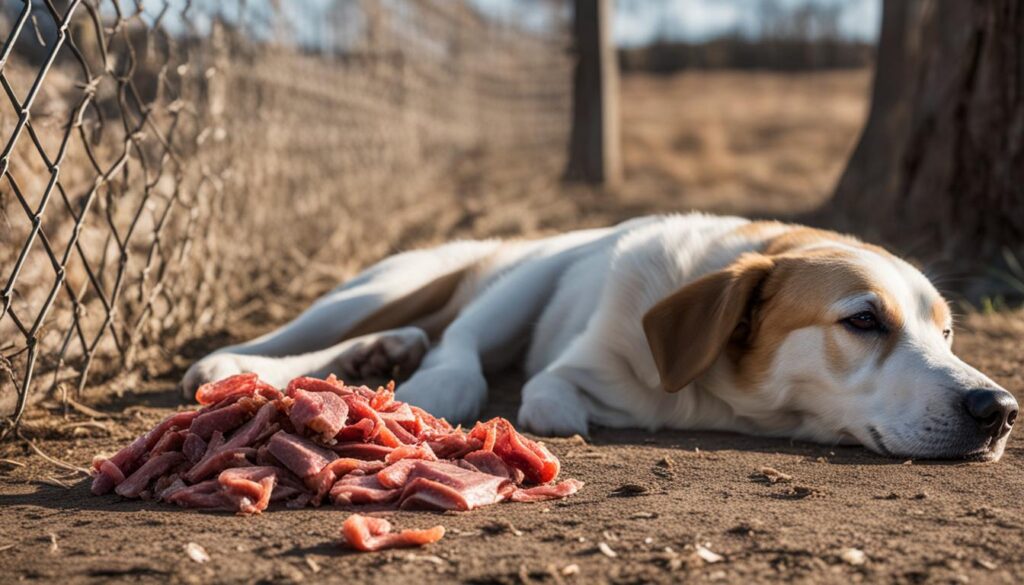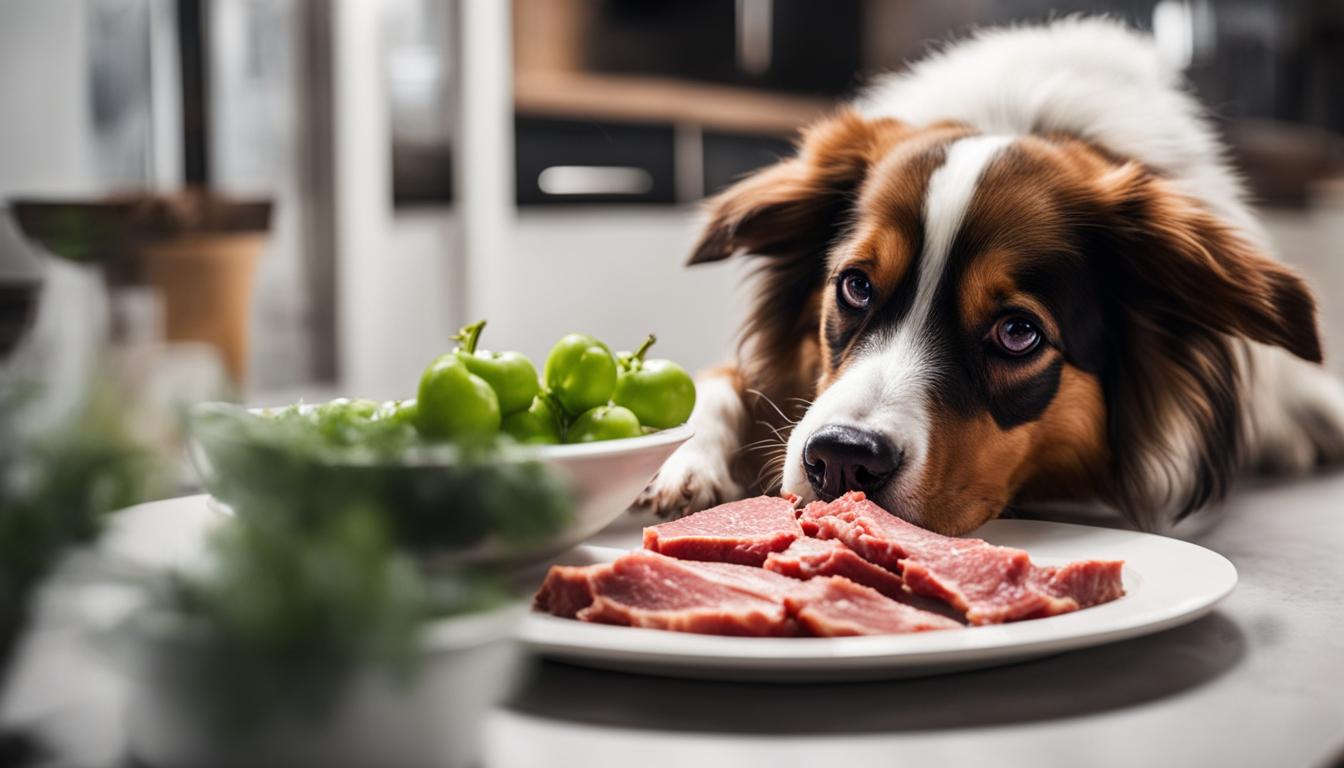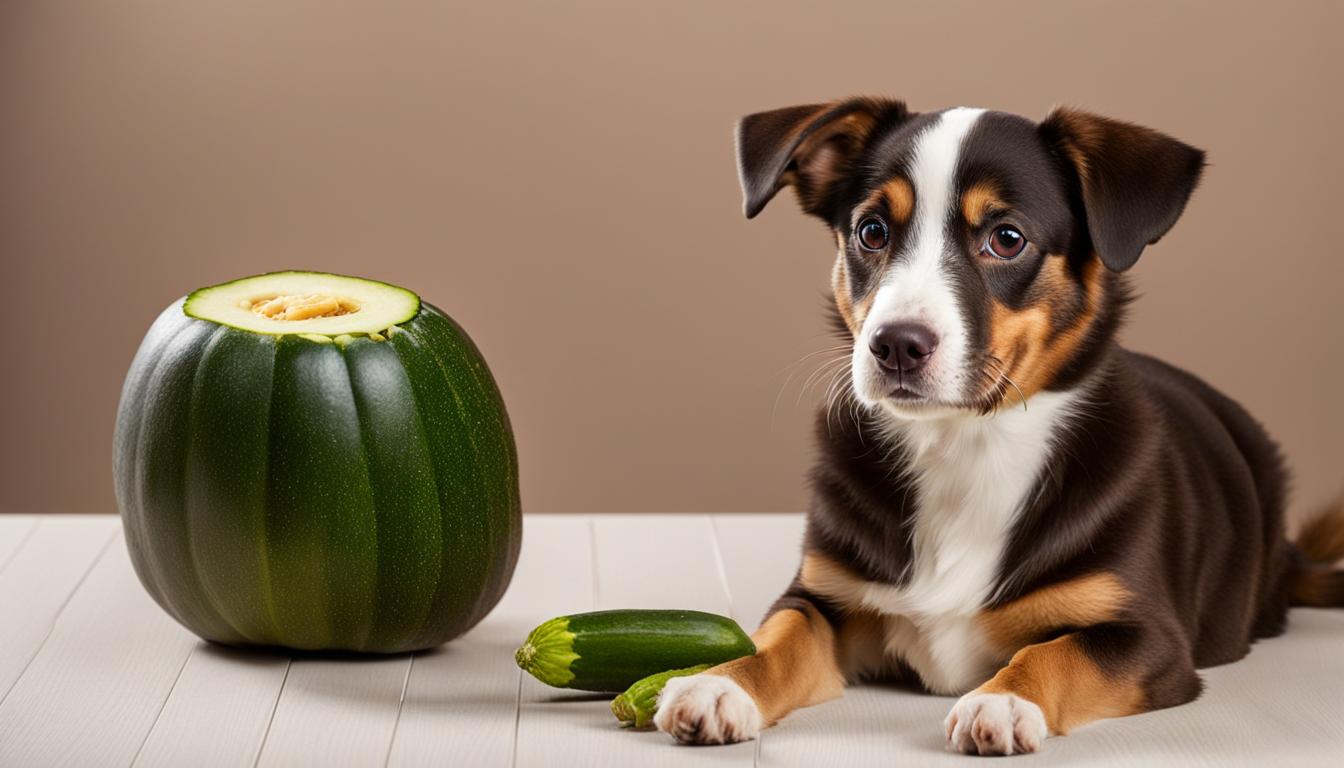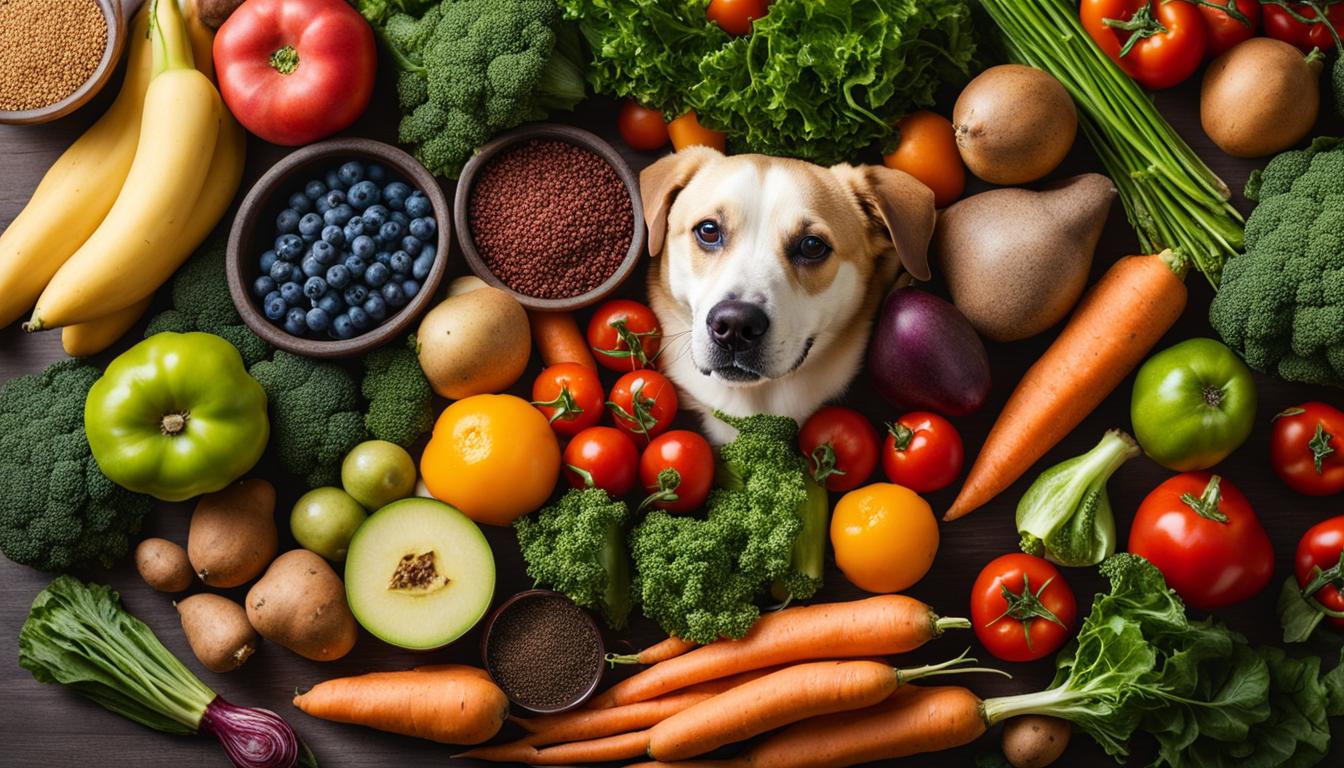Interest in raw diets for dogs has been on the rise in recent years. Many pet owners are curious about the potential benefits of feeding their furry friends a raw meat diet. But before you make any dietary changes for your beloved canine companion, it’s important to weigh the pros, cons, and safety considerations that come with raw meat dog diets.
When it comes to raw meat diets for dogs, there are potential advantages, such as a healthier coat and skin, improved breath and oral health, potential improvement in medical conditions, better digestion, and maintenance of a lean mass and healthy weight. However, there are also potential risks to consider, including the presence of harmful pathogens in raw meat that can affect both dogs and humans, the difficulty of properly balancing nutrients in homemade raw diets, and the lack of regulation for commercially-prepared raw dog food.
Key Takeaways:
- Raw meat diets for dogs have become increasingly popular
- Potential benefits include improved coat and skin health, oral hygiene, and digestion
- Risks include bacterial contamination, nutrient imbalance, and lack of regulation
- Homemade raw diets require careful nutrient balancing or consulting a professional
- Choosing a reputable commercial raw dog food brand is crucial for safety
What is a Raw Diet for Dogs?
A raw diet for dogs is a type of feeding regimen that includes uncooked ingredients such as muscles, bones, organs, raw eggs, dairy, fruit, and vegetables. This diet is often referred to as a raw meat diet or a raw food diet for dogs. The idea behind feeding dogs raw food is that it mimics their ancestral diet, which consisted mainly of raw meat and other natural ingredients. Advocates of raw diets believe that this type of feeding plan can provide numerous health benefits for dogs.
One popular variation of the raw diet for dogs is the BARF diet, which stands for Bones and Raw Food or Biologically Appropriate Raw Food. The BARF diet emphasizes feeding dogs a balanced mix of raw meats, bones, fruits, vegetables, and other natural ingredients.

Potential Risks of Raw Diets for Dogs
While there are potential benefits to feeding dogs raw meat, it is important to be aware of the potential risks involved. One of the main concerns is the risk of bacterial contamination. Raw meat can contain harmful pathogens such as Salmonella, E. coli, and Listeria, which can cause illness in both dogs and humans. These pathogens can lead to symptoms such as vomiting, diarrhea, and in severe cases, even organ failure.
In addition to bacterial contamination, there is also the risk of nutrient imbalance. Homemade raw diets can be challenging to properly formulate and balance, especially without professional guidance. This can result in deficiencies or excesses of certain nutrients, leading to health problems over time. It is essential to ensure that a balanced and complete diet is provided to meet the nutritional needs of dogs.
“Feeding a raw meat diet to your dog may increase the risk of bacterial infections and nutrient deficiencies. It is important to weigh the potential benefits against these risks and make an informed decision.”
Lack of regulation is another risk associated with raw diets for dogs. Unlike commercially-prepared dog food, raw diets are not subject to the same regulatory standards and safety testing. This means that the quality and safety of raw dog food can vary greatly between brands and even homemade preparations. It is crucial to thoroughly research and choose reputable brands that prioritize safety and quality control.
Potential Risks of Raw Diets for Dogs:
| Risk | Description |
|---|---|
| Bacterial Contamination | Raw meat can contain harmful bacteria such as Salmonella, E. coli, and Listeria, posing a risk of illness for both dogs and humans. |
| Nutrient Imbalance | Homemade raw diets can be challenging to balance, leading to deficiencies or excesses of certain nutrients, potentially causing health issues. |
| Lack of Regulation | Raw diets are not subject to the same regulatory standards as commercial dog food, making quality and safety inconsistent across brands and homemade preparations. |
It is essential to weigh the potential benefits against the risks before deciding to feed your dog a raw meat diet. Consulting with a veterinarian or a qualified pet nutritionist can provide valuable guidance to ensure the safety and well-being of your furry friend.

How to Safely Handle Raw Meat for Dogs
When it comes to feeding your dog a raw meat diet, safety is of utmost importance. Raw meat can contain harmful pathogens that can pose a risk to both your dog and your family. To ensure the safe handling of raw meat for dogs, follow these tips:
- Freeze raw meat: Store raw meat in the freezer until ready for use. Freezing helps to kill any potential parasites that may be present.
- Separate raw meat: Keep raw meat separate from cooked food to prevent cross-contamination. Use separate cutting boards, utensils, and food bowls for raw meat to avoid the spread of bacteria.
- Clean surfaces: Wash preparation surfaces, cutting boards, and utensils with hot soapy water after handling raw meat to remove any lingering bacteria. Disinfecting with a diluted bleach solution can provide an extra layer of protection.
- Wash hands: Thoroughly wash your hands with soap and water before and after handling raw meat. This helps to eliminate any bacteria that may have been transferred during the handling process.
Transitioning your dog to a raw meat diet should be done gradually to prevent digestive upset. Start by mixing a small portion of raw meat with your dog’s regular food and gradually increase the amount over time. Monitor your dog’s digestion and overall well-being during the transition process.
Remember, raw meat diets may not be suitable for every dog. Some dogs may have specific health issues or dietary restrictions that make a raw diet unsuitable. It’s always best to consult with your veterinarian before making any significant changes to your dog’s diet.
Commercial Raw Meat Dog Food Brands Comparison
If you’re considering feeding your dog a raw meat diet, you may be overwhelmed by the wide range of commercial raw meat dog food brands available on the market. To help you make an informed decision, we have compiled a comparison of some popular brands, taking into account factors such as ingredients, sourcing practices, quality control, and pricing.
Brand A
Brand A offers a variety of raw meat dog food options, including chicken, beef, and lamb. Their ingredients are sourced from local, sustainable farms, ensuring high-quality and ethical sourcing. They prioritize quality control by conducting thorough testing for bacteria and parasites, providing peace of mind for pet owners. Brand A is competitively priced and offers both meal options and complete diets.
Brand B
Brand B specializes in biologically appropriate raw food (BARF) diets. Their products contain a variety of proteins, including poultry, beef, and fish, and are formulated to provide a balanced nutritional profile. They source their ingredients from trusted suppliers and conduct regular testing to ensure product safety. Brand B offers a range of options, including both patties and bulk packs, to suit different feeding preferences and dog sizes.
Brand C
Brand C focuses on providing raw meat diets that are free from artificial additives and preservatives. They offer a variety of protein sources, including chicken, turkey, and venison, to cater to different dietary needs. Brand C sources their ingredients from reputable suppliers and conducts rigorous quality control checks. While their products are slightly higher priced, many pet owners appreciate the quality and transparency of their sourcing practices.
| Brand | Ingredients | Sourcing Practices | Quality Control | Pricing |
|---|---|---|---|---|
| Brand A | Chicken, beef, lamb | Local, sustainable farms | Thorough testing | Competitive |
| Brand B | Poultry, beef, fish | Trusted suppliers | Regular testing | Varies |
| Brand C | Chicken, turkey, venison | Reputable suppliers | Rigorous checks | Higher |
It’s important to note that this is just a snapshot of a few brands, and there are many other options available. When choosing a raw meat dog food brand, consider factors such as your dog’s specific dietary needs, any allergies or sensitivities they may have, and your budget. Consulting with your veterinarian can also provide valuable guidance in selecting the right brand for your furry friend.
Balancing Nutrients in Raw Meat Diets for Dogs
When it comes to raw meat diets for dogs, ensuring proper nutrient balance is crucial for their overall health and well-being. Dogs require a diverse range of nutrients, including proteins, fats, carbohydrates, vitamins, and minerals, to thrive. However, creating a balanced raw diet can be challenging, especially when preparing homemade meals.
To achieve nutrient balance in a homemade raw meat diet, it is recommended to work with a qualified pet nutritionist or consult with a veterinarian. They can help formulate a diet plan that meets your dog’s specific nutritional needs, taking into account factors such as age, breed, activity level, and any underlying medical conditions. A professional can guide you in choosing the right combination and proportions of ingredients to ensure your dog receives all the essential nutrients.
Commercially-prepared raw diets can also be a convenient option for dog owners who want to feed their pets a raw meat diet without the hassle of preparing it themselves. These diets are usually formulated and tested to meet the nutritional requirements of dogs. However, it is still important to review the ingredient list and nutrient profile of these products to ensure they align with your dog’s needs.
Proper Nutrient Balance in Raw Meat Diets
What nutrients should be included in a raw meat diet for dogs? Here’s a breakdown of essential nutrients and their sources:
| Nutrient | Sources |
|---|---|
| Protein | Raw muscle meat, organs, eggs, dairy |
| Fats | Raw meat, fish, oils |
| Carbohydrates | Fruits, vegetables |
| Vitamins | Fruits, vegetables, offal |
| Minerals | Bones, offal, vegetables |
It’s important to note that specific nutrient requirements may vary depending on your dog’s individual needs. For example, puppies, senior dogs, and dogs with certain health conditions may require additional or modified nutrient levels. Consulting with a professional can help ensure that your dog’s raw meat diet is tailored to their unique requirements.
“A well-balanced raw meat diet can provide dogs with the essential nutrients they need for optimal health and vitality. However, it’s essential to take the time to properly formulate and balance the diet to avoid any nutritional deficiencies or imbalances. Consulting with a professional is highly recommended to ensure your dog’s specific needs are met.”
Conclusion
After exploring the pros, cons, and safety considerations of raw meat diets for dogs, it’s clear that this topic is not without controversy. While there are potential benefits to feeding dogs raw meat, such as healthier coat and skin, improved oral health, and possible improvement in medical conditions, it’s important to approach raw diets with caution and awareness.
Risks associated with raw diets include the potential for bacterial contamination, nutrient imbalance, and a lack of regulation in the industry. Raw meat can contain pathogens that are harmful to both dogs and humans, making proper handling and hygiene practices essential. Additionally, balancing the nutrients in homemade raw diets can be challenging without professional guidance, and many commercially-prepared raw dog foods lack feeding trials to evaluate their safety.
When considering a raw meat diet for your dog, it’s crucial to make an informed decision. Consult with a veterinarian to weigh the potential benefits against the risks and to ensure that your dog’s nutritional needs are being met. Remember, there is limited scientific evidence supporting the benefits of raw diets, so it’s important to prioritize your dog’s health and well-being above all else.
FAQ
Are raw diets safe for dogs?
Raw diets can pose potential risks due to the presence of pathogens in raw meat. It is important to handle raw meat properly and consult with a veterinarian to ensure a balanced and safe diet for your dog.
What are the potential benefits of feeding dogs raw meat?
Some potential benefits include a healthier coat and skin, improved breath and oral health, possible improvement in medical conditions, improved digestion, and maintenance of lean mass and healthy weight.
Can raw meat diets improve my dog’s overall health?
While there are claims of improved health on raw diets, the scientific evidence is limited. It is important to consider both the potential benefits and risks before making a decision.
How do I handle raw meat safely for my dog’s diet?
To reduce the risk of contamination, it is important to follow proper hygiene practices such as freezing raw meat, keeping it separate from cooked food, cleaning preparation surfaces, and washing hands before and after handling the meat.
Can I feed my dog commercially-prepared raw dog food?
Yes, there are many commercial brands available on the market; however, it is important to research and compare different options to find a reputable and safe brand that meets your dog’s nutritional needs.
Is it necessary to balance nutrients in raw meat diets for dogs?
Yes, proper nutrient balancing is crucial to ensure your dog’s overall health. Consulting with a qualified pet nutritionist or veterinarian is recommended to ensure a balanced diet.
Should I consult with a veterinarian before starting a raw diet for my dog?
It is highly recommended to consult with a veterinarian to discuss the potential benefits and risks, as well as receive guidance on choosing the right diet and ensuring it is safe and balanced for your dog’s specific needs.





